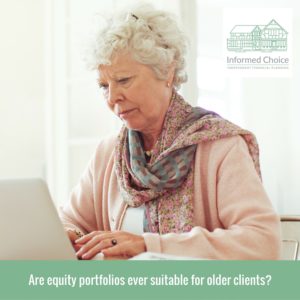 As we get older, received wisdom suggests we should reduce the risk in our investment portfolios.
As we get older, received wisdom suggests we should reduce the risk in our investment portfolios.
A big reason for this is time.
The older we get, the less time we have to remain invested and recover any losses associated with the volatility from higher risk investments.
One financial rule of thumb is to hold the equivalent percentage of your portfolio in fixed income securities as your age in years.
So a 40 year old might consider holding 40% in fixed income and 60% in equities, whilst an 80 year old would only expose 20% of their holdings to equity risk.
I was prompted to write about this after seeing a ruling by the Financial Ombudsman Service who decided an advice firm should not have been recommended any investment to a 70 year old investor.
The investor, who is referred to by the Ombudsman as Miss G, was in receipt of a substantial pension income.
She had never made any investments and suffered from a life-threatening illness.
Despite these factors, the adviser in question recommended that Miss G invest £500,000 into a one open-ended investment company which (in the words of the Ombudsman) “exposed around 50 per cent of that money to the vicissitudes of the world’s stock markets.”
The Ombudsman commented in their ruling:
“I don’t see why Miss G, with so much money and no dependents, and with a life-threatening illness, would wish to subject herself to the as yet untried, the unfamiliar and potentially nerve-racking experience of watching her fund value – which comprised nearly all of her assets in one place – rise and fall in line with the world’s stock market.
“And indeed when Miss G found herself subjected to that experience, it was too much for her.”
As this case highlights, there will be occasions where it is unsuitable for older investors to take on so much equity risk.
The investor described in this ruling – 70 years old, in poor health, with no investment experience and in receipt of a substantial pension income – would seem to fit the profile of an investor who should not be investing a large amount of her money in equities.
Having a substantial pension income suggests that Miss G did not need to invest money in this way.
Being 70 years old and in poor health suggests that Miss G did not have the capacity for investment losses.
Her lack of investment experience suggests Miss G did not have a sufficiently high enough attitude towards investment risk, reward and volatility to make this type of investment.
So what would a good alternative have looked like?
Without knowing all of the facts in this case and finding out more about Miss G’s goals, I would feel uncomfortable outlining an alternative approach.
What would seem appropriate though would be to use lifetime cash flow forecasting to determine, based on reasonable assumptions about the future, whether it was necessary to take any equity-style investment risks, and if so at what level.
If equity risks were unnecessary in order to achieve financial goals, then keeping the capital in cash savings – and helping Miss G to identify the most competitive interest rates available from appropriate term deposit accounts – would seem a more reasonable approach.
Only invest if you want to invest, need to invest and have the capacity to invest.
This principle applies equally to a 70 year old investor as it does to a 40 year old investor.

